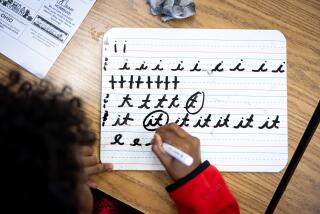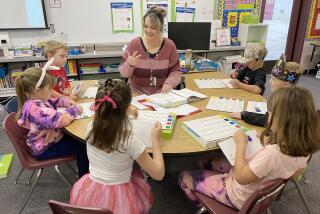Japanese Bows In : Elementary school students are learning the language and culture in a unique program that may fit them for adult roles in world commerce.
- Share via
SAN CLEMENTE — The mood in the room is serene as a young hostess greets her guest with a traditional Japanese bow, her hands clasped demurely in front of her. To show his respect, the guest bends forward in a deep bow, removes his shoes in customary Japanese style and is ushered in for a cup of tea.
Such scenes are typical in Japan, but this particular home visit took place last week at Concordia Elementary School with a group of giggling fifth-graders wearing sneakers and T-shirts. As part of a special program designed to expose children to new languages and cultures, all 700 students at the school began learning Japanese last fall.
The school hired three Japanese teachers after receiving an $80,000 federal grant for schools interested in teaching Japanese or one of four other foreign languages. There are few if any other Japanese-language programs for elementary school pupils in California, school officials said.
“The reaction from parents has been overwhelmingly positive, but sometimes people will ask, ‘Why Japanese?’ ” said Principal Kathy Oshima George, adding that there are few children of Asian ancestry at the school.
“And I always tell them that Japanese is definitely a business language now and for the future. I think foreign languages are extremely important for children to learn at a young age, because that’s when they have the most faculty for new languages.”
To acquire basic conversational skills, students attend Japanese language and culture classes either once or twice a week, depending on their grade level. In addition to learning common Japanese words and phrases, students in the program are learning how to use chopsticks, make sushi and create Japanese arts and crafts.
“I can say things in Japanese like, ‘what do you like to drink,’ ‘thank you,’ and ‘here you go,”’ said Kyle Milner, a fifth-grader. “I used to be able to count to 100, but I forgot.”
Last week, students in one class learned how to properly accept and receive tea, uttering the obligatory dozo, which means, “here you are,” and arigato, which is Japanese for “thank you.”
As they pretended to drink tea while kneeling on cushions, the youngsters playfully exaggerated the sipping sounds.
“Remember, it’s just a slurp,” said teacher Bonnie Hamm, who taught in Japan for 13 years and speaks Japanese fluently. “It’s not a pig trough.”
At the other end of the room, Japanese teacher Setsuko Koyama had her group sing a Japanese song and recite a few basic Japanese words--tasks they did enthusiastically.
Among those most eager to shout their responses were children whose native language is Spanish.
“We were a little concerned in the beginning that Japanese might confuse some of the Spanish speakers because they already know a second language,” George said. “But one of the unexpected bonuses of this program is that they are doing great in this class because they already have a faculty for languages. It’s given them wonderful opportunities to be leaders and it’s built their self-esteem.”
Pablo Fernandez, a fifth-grader who speaks Spanish at home, said learning Japanese has been “really fun.” He now practices his Japanese at home with his brother, who also attends the school.
“We say, ‘hello,’ ‘goodbye’ and ‘good morning,’ ” he said. “My parents think it’s great because they know learning Japanese will help me get in touch with more people.”
Before receiving the three-year federal grant, Koyama had been teaching Japanese to some students at the school on a voluntary basis. The federal funding, however, enabled the school to extend Japanese classes to all students.
George said she plans to apply for additional funds to continue the program both at her school and eventually at local middle and high schools.
“If the children can get about five or six years of Japanese, they would be so marketable when they graduate,” George said.
The school also hopes to incorporate computer technology into the Japanese curriculum, allowing students to communicate with children in Japan through the Internet.
Sandy Schwartz, the school’s PTA president, said parents were elated when the school initiated the program because they strongly support their children learning foreign languages.
“A lot of people realize that their children need to learn multiple languages, and that it’s best taught at a young age,” she said. “My housekeeper speaks Japanese, and she explained to me that adults can’t get the Japanese accent right because their tongues are too well trained. But kids pick it up so fast because they’re open to learning new things.”
More to Read
Sign up for Essential California
The most important California stories and recommendations in your inbox every morning.
You may occasionally receive promotional content from the Los Angeles Times.













